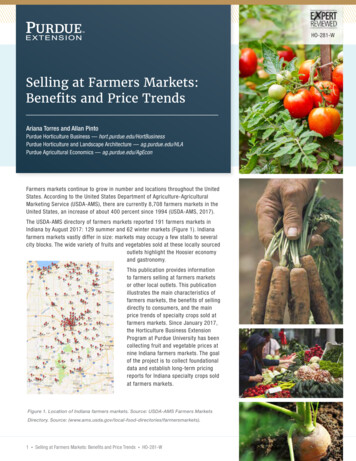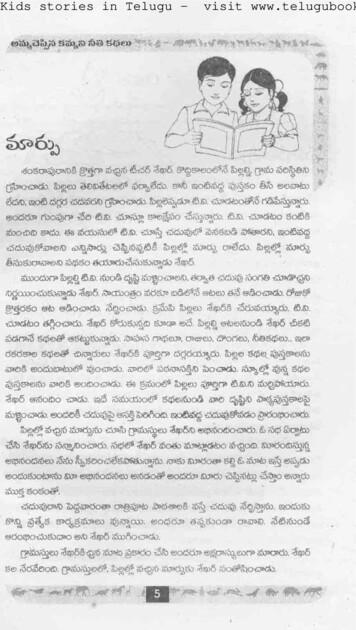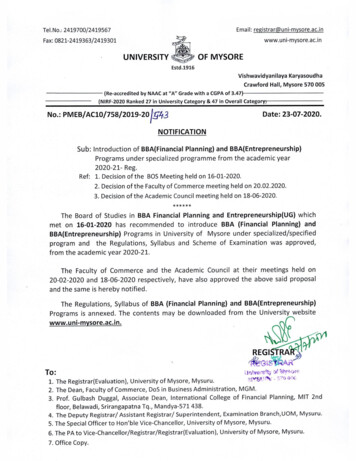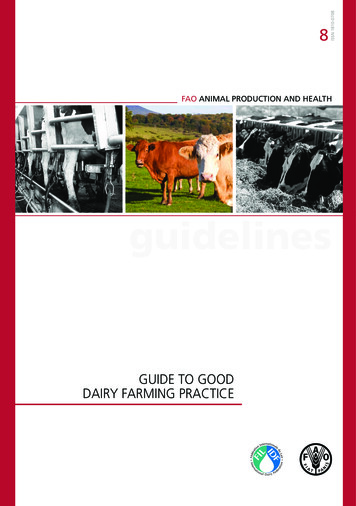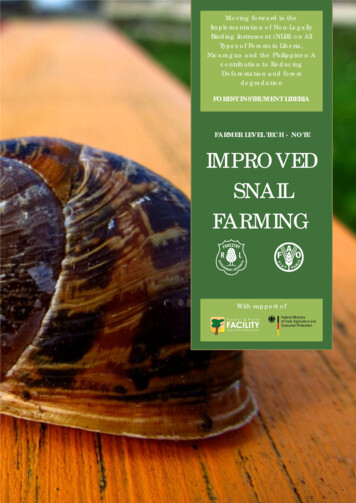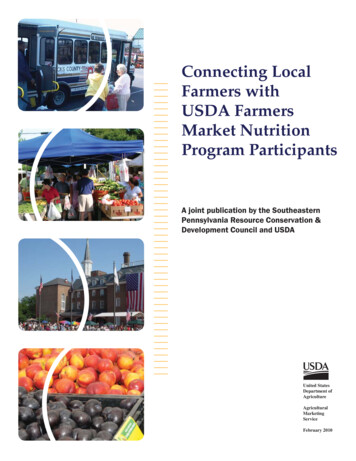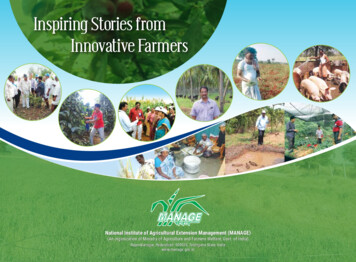
Transcription
Inspiring Stories fromInnovative FarmersNational Institute of Agricultural Extension Management (MANAGE)(An organization of Ministry of Agriculture and Farmers Welfare, Govt. of India)Rajendranagar, Hyderabad- 500030, Telangana State, Indiawww.manage.gov.inInspiring Stories from Innovative Farmers1
Published byNational Institute of Agricultural Extension Management (MANAGE)(An organization of Ministry of Agriculture and Farmers welfare, Govt. of India)Rajendranagar, Hyderabad- 500030, Telangana State, India MANAGE, 2018Compiled and Edited byDr. MuttannaSenior Research Fellow (SRF)Centre for Agricultural Extension Policy, Public Private Partnership in Extension and InternationalCentre of Excellence in Agricultural ExtensionNational Institute of Agricultural Extension Management (MANAGE)Rajendranagar, Hyderabad- 500030, Telangana State, IndiaE-mail: muttanna.bk@gmail.comDr. Lakshmi MurthyDeputy Director (Documentation)National Institute of Agricultural Extension Management (MANAGE)Rajendranagar, Hyderabad- 500030, Telangana State, IndiaE-mail: lakshmi@manage.gov.inDr. Saravanan RajDirector (Agricultural Extension)National Institute of Agricultural Extension Management (MANAGE)Rajendranagar, Hyderabad- 500030, Telangana State, IndiaE-mail: saravanan.raj@manage.gov.inPrinted at: Vamsi Art Printers Pvt. Ltd.2Inspiring Stories from Innovative Farmers
MessageIndia has made tremendous advancement in food production moving from a fooddeficit to a food surplus country, as a result of scientific research, innovations,technological advancements and developed extension services. Studies indicate thatof late, many farmers are quitting agriculture due to various reasons and movingto cities in search of better livelihood. Often this is attributed to distress but thereare many farmers who have been highly successful and flourishing despite thechallenges and constraints. Through innovations and efforts, these farmers havenot only transformed their own lives but that of others too. Documenting anddisseminating success stories of farmers can inspire millions of farmers across India.Dr. S.K. PattanayakSecretary (AC & FW)MANAGE has compiled the stories of different farmers with a view to inspire farmersto strengthen their belief in themselves and their own abilities.I compliment and congratulate MANAGE for documenting and skillfully depictingthe challenges of individual farmers who have tasted the fruits of success in the end.(S.K. Pattanayak)Inspiring Stories from Innovative Farmers3
AcknowledgementMANAGE would like to acknowledge everyone who contributed to the compilation of success stories of farmers. MANAGE extends sinceregratitude to all the farmers from different states of India for providing valuable information that helped us to strengthen the book considerably.Last, but most important, we also thank all faculty members and technical staff for their contribution during the preparation of this book.4Inspiring Stories from Innovative Farmers
Sl. No.ContentsTitlePage. No.1The Millet Man of Telangana72Award-Winning Piggery Enterprise of Bijapur93Trendsetter of Cattle based Organic Farming in Andhra Pradesh114The Spice Rich Farmer of Karnataka135The Way Forward for Sustainable Agriculture156Rural Entrepreneurship through Amla Farming177All is Well in Integrated Farming198Integration in farming leads to prosperity219The Sweet Taste of Success with Bee-Keeping2310Farmer converts Adversity into Opportunity2511Success in Agriculture leads to Success of Ecosystem2712Every drop counts2913More Crop per Drop3114Crop Diversification is the way forward in Punjab3315Dairy Farming flourishes with fodder crops3516Prosperous Dairy Farming through Crossbreeds in Karnal3717Zero Budget farming3918Integration is the New Success Mantra for Sustainable Agriculture4119Award winning horticulture farmer from Karnataka4320Composite farming4521Where there is a will, there is a way4722Empowered Women run a Successful Dairy Venture4923Success through Post-Harvest Technologies & Marketing of Fruits5124Leading the way in Fisheries: Kailash Fisheries Aquatics5325Enriching Natural Resources for Sustainable Farming55Inspiring Stories from Innovative Farmers5
6Inspiring Stories from Innovative Farmers
The Millet Man of TelanganaHe takes up millets in June-July with the onset of the south-westmonsoon. He manages to get a good yield from millets (foxtail millet3-3.5 quintals/acre, bajra 4-5 quintals/acre, sorghum 4-5 quintals/acre and finger millet 4-5 quintals/acre) with proper managementpractices at the right time even though his village receives meagrerainfall.Mr. Veer Shetty Biradar (44) is from Gangapur village, Jharasangammandal, in Sangareddy district of Telangana State, India. He is agraduate and owns 13 acres of dryland and 5 acres of irrigated land.He grows sugarcane, chickpea, red gram, jowar, bajra, foxtail milletand finger millet.Once, while travelling to Maharashtra, Mr. Biradar could not getany food to eat and suffered from starvation as a result. He startedthinking of producing food for the future generations after comingback from Maharashtra.He started growing millets and entered the field of value-added milletproducts under the technical guidance of Dr. C.L. Gowda, DeputyDirector General, ICRISAT, and Dr. C.H. Ravindra Reddy, Director,MSSRF (M.S. Swaminathan Research Foundation), Jeypore, Odisha.One of the reasons for focusing on value added millet products isthe emergence of lifestyle diseases among the urban population andprevalence of junk food consumption among the youth. Keepingall these factors in mind, in 2009, Mr. Biradar started a valueadded centre for millets in Huda Colony, Chandanagar, Hyderabad,Telangana, India, in the name of SS Bhavani Foods Pvt. Ltd. Within aspan of seven years, his company developed 60 value-added milletproducts from sorghum, bajra, foxtail millet and finger millet.According to Mr. Biradar, millets are super foods for the futuregeneration because the risk of pest and disease attack is comparativelylow, except for bird damage. He believes a farmer and a jawan arethe two eyes of our country. Keeping the farmer in mind, he starteda Non-Governmental Organization (NGO) called Swayam Shakthiin Huda Colony, Chandanagar, Hyderabad. The NGO covers 1000farmers from 8 villages from Sangareddy district. The main purposeof the NGO is to disseminate timely information to farmers and takenew technologies to the doorstep of the farming community.Inspiring Stories from Innovative Farmers7
Mr. Biradar received technical guidance about millet processing,types of machinery etc. from Indian Institute of Millets Research(IIMR), Hyderabad, Telangana. He also started working with an IndianCouncil of Agricultural Research (ICAR) project called FARMER FIRSTin collaboration with IIMR. He started another value-added centre(shop) on February 27, 2017, to expand the coverage of millet-basedvalue-added products. He also delivered a seminar on “Underutilizedcrops for nutritional security” at MSSRF, Jeypore, Odisha, followedby a field visit to educate farmers in Odisha.He believes all millet-based value-added products should be madeavailable all the year round for everyone irrespective of the place. Mr.Biradar faced many challenges in his journey of developing milletbased value-added products and quotes the proverb “stones andsticks are thrown only at fruit-bearing trees” when remembering hisjourney. He earns Rs. 1 lakh per month from SS Bhavani Foods Pvt.Ltd.Mr. Biradar’s work hasbeenacknowledgedthrough several awardsforhisremarkableachievements in milletsbasedvalue-addedproducts,including‘Best Farmer Award’,from MS SwaminathanResearch Foundation(MSSRF),Jeypore,Odishain2017,‘Dr. M.V. Rao MemorialAward’ from ProfessorJayashankar Telangana State Agricultural University (PJTSAU) in 2017and ‘Best Millet Misharayya Award’ from Indian Institute of MilletResearch (IIMR) Hyderabad in 2017. He earns Rs. 3-4 lakh annuallyfrom agriculture, apart from millet-based value-added products. Infuture, he wants to start ready-to-eat millet foods and wishes tocover maximum regions across the country.Mr. Veer Shetty BiradarGangapur Village, Jharasangam Mandal,Sangareddy District, Telangana State, India.Mobile Number: 91 7702860613Authors: Dr. Muttanna, Senior Research Fellow (SRF), Dr. Ravi Nandi,Program Manager FTF-ITT, Ms.Shakera Parveen, Program Executive,FTF-ITT, National Institute of Agricultural Extension Management(MANAGE) Rajendranagar, Hyderabad- 500030, Telangana State,India.8Inspiring Stories from Innovative Farmers
horticulture crops; in this way, he has reduced the usage of chemicalfertilizers by 50 to 60 per cent.Award - Winning PiggeryEnterprise of BijapurTo reduce the feed cost, he formulated a homemade concentrate feedfor piglets using available grains such as corn, rice, wheat, groundnut,mineral mixture and salts in an appropriate proportion. In the morning,he gives concentrate feed to the pigs, and in the evening, he feedsMr. Somanna Siddappa Bhasagi (39) is from Alamel village, Sindagitaluk, Bijapur district, of Karnataka, India. He started farming in 2009,before which he was a scrap merchant. In 2009, he purchased 2.5acres of land, which yielded 40 to 45 tonnes of sugarcane per acre.In 2010-11, he leased 6 acres of land and continued the earliersubsistence farming system.He was not satisfied with the market price of field crops and sugarcaneand started thinking of trying innovative methods of farming insteadof growing regular crops. That’s when he got the idea of starting apiggery that could function with low rearing cost and high returns.To start the piggery, he received training and guidance of Dr. L.K.Jayaramayya at Piggery Breeding Centre, Hesaraghatta, Bengaluru.After the completion of his training program, Mr. Bhasagi put his richknowledge about pig rearing to practice and purchased 20 pigletsfrom the same breeding centre on June 16, 2014.He started a piggery at Alamel, equipped with the necessary facilitiesand with a shed size of 60”x100” for 20 piglets. To tackle the issue offrequent electricity cuts, he got a generator installed. He has placedparticular emphasis on cleanliness, washing the shed twice a dayto avoid diseases. All the waste from the pig shed is collected in atank with a capacity of 8 to 10 litres and is diverted to the field andInspiring Stories from Innovative Farmers9
them semi-solid wastegenerated from nearbycity restaurants. The littersize is 16-18 piglets peryear.He sells piglets at the rateof Rs. 3,500 per piglet tointerested farmers. Healso has a good marketlink for selling pork to Goaand in Hassan district ofKarnataka. In the spanof three years, he hasincreased the number ofpiglets from 20 to 200,with an annual turnover ofRs. 4 to 5 lakh.Apart from pig rearing,Mr. Bhasagi purchased4.50 acres of land in 2015 and started practising mixed croppingand inter-cropping. In order to make use of the space between twocrops, he grew pumpkin and earned Rs. 2 lakh in a single season. Healso cultivates commercial crops such as sugarcane and cotton. Toregulate his income throughout the year without spending much oninputs, he started growing horticultural crops such as mango, guavaand lemon. He also planted 110 coconut trees around the farm,which yield an average of 80-100 nuts per tree.He gets Rs. 4.5 to 5 lakh net profit from farming, which is inclusive ofpiggery. In future, he wants to purchase land and is willing to expand10Inspiring Stories from Innovative Farmerspiglets and horticulture crops, particularly vegetables. He wants tobe independent and aims to be a role model for his fellow farmers.For his work, he was awarded the Progressive Farmer Award by theUniversity of Agricultural Sciences (UAS), Dharwad.He encourages the youth to take up agriculture and allied activitiessuch as poultry, piggery, goat and sheep rearing, apiculture,horticulture, fishery and value addition in millets for increasingproduction and productivity at the farm gate instead of waiting forgovernment jobs, subsidy, insurance and crop loans. Mr. Bhasagisums it up perfectly when he says “farming is close to nature; thehappiness and peace that we get from farming cannot be comparableto any other business in the world”.Mr. Somanna Siddappa BhasagiAlamel (Village), Sindagi (Taluk), Bijapur (District)Karnataka, India.Mobile Number: 91 9845075311Author: Dr. Muttanna, Senior Research Fellow (SRF), National Instituteof Agricultural Extension Management (MANAGE) Rajendranagar,Hyderabad- 500030, Telangana State, India.
the production cost, which in turn saves energy and protects theenvironment in the long run.Trendsetter of Cattle-Based OrganicFarming in Andhra PradeshMr. Gadde Satish (47), is a post-graduate in commerce and is fromSeethampeta village, Denduluru mandal, Eluru, in West Godavaridistrict of Andhra Pradesh, India. He continues farming even inthe present scenario where many farmers feel that farming is notprofitable any more, due to pests and diseases, stagnation of cropyields, shortage of labor and high cost of cultivation. He owns 16acres of coconut plantation, cultivates paddy in 19 acres and cornin 20 acres. He also owns 37 buffaloes, including calves, heifers andadults.He follows open grazing in the daytime, and during night-time,animals are tied in rows across the farm using a long rope; on alternatedays, the rope is shifted a few meters ahead in order to change theresting place/position of the animals. This way, dung and urine of theanimals is allowed for absorption by the land insitu. The farmyardmanure, enriches soil fertility and reduces weeds. Mr. Satish says theavailability of labour is a major problem, and to minimize this problem,he uses the basin method of irrigation for coconut orchards. Alongwith open grazing, he feeds paddy straw to the animals during leanperiods of fodder. Flood irrigation through field canal allows for deeprooting of coconut trees and plant becomes stress tolerant.He learned about cattle-based organic farming from his father andwent ahead with it because he believes this is the best farming systemand is environment friendly as well. He continued with the cattlebased organic farming system in the contemporary era in spite of therisk and uncertainty associated with it because he had observed thesuccess of this farming system in his family since the 1990s.According to Mr. Satish, dairy animals are part of organic farmingsystems because of the complementary and supplementaryrelationship between both enterprises. One of the many advantagesof cattle-based organic farming is that there is no dependenceon expensive chemical fertilizers, which leads to reduction inInspiring Stories from Innovative Farmers11
Mr. Satish says that due to natural grazing, animals are not affectedby fertility and reproductive problems. Since the whole milk is left forcalves it is helping the calves to grow healthy. As per his experience,proper management practices lead to animals attaining maturity andconceiving at the age of 24 months, whereas in other cases, it maytake a longer period. He grows 19 acres of paddy organically, withoutusing any fertilizer and pesticides. He adds paddy residues in thesoil to enhance the organic matter content, which helps build up soilmicroorganisms and increases soil fertility.Paddy grown organically, once harvested is left in the field or insitudrying for a week, then heaped in one place and left for three monthsfor curing. After threshing and winnowing, the paddy is stored forabout a year, milled and sold as organic rice at a premium price.He believes the organic method of rice cultivation has additionalnutritional value and taste compared to the inorganic method.He has good linkages with extension officers in agriculture andanimal husbandry departments. He has also participated in severalseminars and meetings related to farming and was awarded the BestCattle-Based Organic Farming Practice award by Indian Council ofAgricultural Research (ICAR)-Indian Institute of Rice Research (IIRR),Hyderabad.He has been recognised as a progressive farmer and he is well knownfor his rich knowledge of organic farming. He does not hesitate insharing his experience with farmers and other senior officers inagriculture and allied departments.He believes that cattle-based farming is a way of life because of thecredibility of the organic method of cultivation, reduced dependenceon external inputs, minimum usage of labour and high marketdemand for organic products due to the emergence of lifestyle12Inspiring Stories from Innovative Farmersdiseases. He has not encountered major pest attacks or diseasesacross his cropping pattern. He gets a premium price for organic rice,which starts from Rs. 80/- to Rs. 100/- per kg. He considers organicfarming a culture and a tradition. In future, he wants to increase thenumber of buffaloes he owns from 37 to 60 for better income andsustainability.Mr. Satish plans to work in collaboration with the tourism departmentto start agro-tourism and dairy tourism to educate and disseminatebetter farming practices. He has given valuable advice to farmersto not consider farming in terms of economic terms and monetarybenefits alone but accept it as a sustainable way for the futuregeneration. He believes every farmer should follow the integratedway of farming as this results in complementary and supplementarymethods that enhance the productivity of crops.Mr. Gadde SatishSeethampeta (Village), Denduluru (Mandal), Eluru,West Godavari (District), Andhra Pradesh, India.Mobile: 91 9912511244Author: Dr. K. Uma Rani, Director (Retd.), National Institute ofAgricultural Extension Management (MANAGE) Rajendranagar,Hyderabad-500030, Telangana State, India.
The Spice Rich Farmerof KarnatakaMr. D.M. Ramesh (59), is from Daradahalli village, Mudigere taluk,Chikkamagaluru district, Karnataka, India. He has studied up to thepre-university level. He currently owns 15 acres of land and growsplantation crops such as coffee, pepper and areca nut.According to Mr. Ramesh, the manner in which we grow in a societydepends on the environmental condition of a particular area. He hasa deep interest in farming because his ancestors used to practisecultivation. He wanted to cultivate plantation crops but he did notpossess his own land due to absolute poverty and hence could notachieve his dream. He shifted from Coorg to Mudigere in search ofa job. He started Seetha Bangles Store in the year 1987 in Mudigereto earn his livelihood.After a couple of years, he got married and entered the timber businessto increase the family income. Though he earned sufficient moneyfrom the timber business, he was not satisfied and discontinuedworking in it. Later, he purchased 15 acres of land in Daradahalliand started cultivating coffee, pepper, banana and areca nut in theyear 1995. For five years, he got a good yield, which brought himimmense happiness.However, between the years 2002 and 2008, coffee rates decreaseddrastically from Rs. 3,500/- to Rs. 700/-. Even though he facedmultiple hardships in this time, he did not quit farming. He continuedbecause he strongly believed that farming would never fail him if heworked hard and with devotion. He left the city and started living atthe farm from 2004 onwards to fully focus his efforts on farming; bythis time, his bank loan increased to around Rs. 40 lakh.He continued farmingwhilefacingtheups and downs oflife during the badperiod. From 2008onwards, he startedgetting a good pricefor coffee, pepper andareca nut. He startedrepaying the bankloan in instalmentswith some assistancefrom the government.AccordingtoMr.Ramesh,anaverageof6080 inches rainfallis needed for thecultivation of pepper,and special care shouldbe taken for pepperleaves from June toOctober in order toavoid exposing themto heavy rainfall, andInspiring Stories from Innovative Farmers13
from March to May, adequate irrigation should be provided throughsprinklers.He used Farm Yard Manure (FYM) for the effective growth anddevelopment of plantation crops. He used Bordeaux paste 2.5 feetabove the ground level and applied neem cake and Trichoderma toprotect the crops from pathogens. He also applied chemical fertilisersin the months of June and September, which ranged from 400 to500 grams of NPK per pepper plant. Pepper plants are known toget the leaf spot disease during heavy rainfall; to tackle this, he tookpreventive measures by using a spray of Bavistin (Carbendazin 50%WP). He also took up the advisable application of Thimet to avoidroot diseases.Mr. Ramesh believes that an experienced farmer is a real agriculturescientist. He mentions that the pepper plant is very sensitive, andspecial care should be taken at almost each stage of its growth. Hegets 8 1/2 tonnes of pepper, 450 bags of coffee and areca nut peryear and is earning around Rs. 40 lakh as his annual income. Heattributes his success to hard work, taking right decisions at the righttime and applying scientific practices for cultivating crops.He was awarded the Progressive Farmer award by the University ofAgricultural and Horticultural Sciences, Shivamogga, Karnataka, andhe also received the Best Farmer award from Black Gold League (BGL),a Pepper Growers Training Institute in Mudigere, Chikkamagaluru.Mr. Ramesh believes that farmers do not need more than 50 acresof land for successful farming; they need dedication and continuousefforts. He also suggested that the youth “take up agriculture andallied activities and preserve our ancestral occupation for futuregenerations”.Mr. D.M. RameshDaradahalli (Village), Mudigere (Taluk),Chikkamagaluru (District), Karnataka State, India.Mobile: 91 9242144019/ 91 9480738978Author: Dr. Muttanna, Senior Research Fellow (SRF), National Instituteof Agricultural Extension Management (MANAGE) Rajendranagar,Hyderabad - 500030, Telangana State, India.14Inspiring Stories from Innovative Farmers
The Way Forward forSustainable AgricultureMr. S. Sukhdev Singh (60), is from Bhullar Bet village in Kapurthaladistrict of Punjab, India. He studied up to matriculation and has beenpractising agriculture since his childhood. The land he inheritedwas barren, saline with no irrigation facilities and yielded very little.Under the land reclamation programme, he witnessed a tremendousimprovement in soil fertility with gypsum application.Earlier, he followed the traditional paddy-wheat cropping system.With improvement in soil fertility, he switched to other crops, suchas sugarcane, potato, mustard, berseem and maize etc. Gradually,through sheer hard work, his income from agriculture startedincreasing. Now, he cultivates 74 acres of land, growing diversifiedcrops. He has become a perfect example of a rags-to-riches story.He was trained under extension centres of Punjab AgriculturalUniversity, Ludhiana, and Farm Advisory Service Centre (FASC),Kapurthala. With his rich knowledge of agriculture and alliedsectors, he got inspired to cultivate improved varieties of crops. Hisproduction of wheat, maize, rice and sugarcane increased manifoldwith the cultivation of improved varieties of PAU, Ludhiana. Now heregularly participates in extension programmes such as kisan melas,field days and crop seminars organised by extension centres of PAU.He irrigates crops through the underground pipeline system to cutdown on losses through evaporation. To prevent distress sale inthe market, he stores his agriculture produce, such as basmati andmaize, in storage structures to sell in future at a higher rate. As atech-savvy farmer, he utilises his smart phone and the Internet for gettinglatest rates from agri-markets, weather information and advancedagri-tech on different websites and shares the information with hisfellow farmers for mutual benefit.Mr. Singh experiments at his farm and shares the results withscientists. He has observed the effect of alternate wetting andInspiring Stories from Innovative Farmers15
drying of wheat and concluded that it enhances germination, tilleringand productivity. In compliance with the orders of the districtadministration, he sows wheat on 15 acres and oats fodder on 5acres with Happy Seeder every year. Therefore, he does not burnthe paddy straw but rather ploughs it back into the soil to improvethe environment and soil fertility and attain sustainable productivity.He has an uncanny flair for growing diverse crops such as wheat, rice,basmati, oats, turmeric and marigold. This cropping pattern fetcheshim a gross annual income per acre of Rs. 30,000/- from wheat, Rs.40,000/- from rice, Rs. 27,000/- from basmati, Rs. 40,000/- frommaize, Rs. 20, 000/- from oats, Rs. 2,40,000/- from turmeric and Rs.30,000/- from marigold cultivation.He also maintains a dairy enterprise comprising 9 milch animals. Fourbuffaloes and five H.F. Cows produce about 126 quintals of milk perannum. After sparing milk for domestic consumption, the surplusmilk is sold to dairy units, which fetches him an annual income Rs.3,78,000/-. Mr. Singh has been bestowed with Dalip Singh DhaliwalMemorial Award for crop diversification by PAU Ludhiana in 2017.He is a successful amalgamation of modern farming using agrotechnologies, economic prosperity and human values combined withsimplicity, thriftiness and knowledge.Mr. S Sukhdev Singh BhullarBhullar Bet (Village), P O Nurpur LubanaKapurthala (District), Punjab, India.Mobile: 91 9814565706Author: Dr. Pardeep Kumar, District Extension Specialist (Agronomy), Farm Advisory ServiceCenter, PAU, Ludhiana, Punjab, India.16Inspiring Stories from Innovative Farmers
Rural Entrepreneurship throughAmla FarmingMr. Amar Singh, aged 60 years, is an inspiration to all cereal andpulses farmers in Rajasthan who want to venture into horticultureand improve their income. His hard work and dedication has led tohis success story being shared all across Rajasthan.The turnover of his business is around 26 lakh in one season fromAugust to February. He is keen to learn new things and never missesan opportunity to interact with experts in the agriculture and animalhusbandry fields whenever he meets them in the village or at thepanchayat, where he makes frequent business visits.The Amla fruits from his field used to be sold at Rs. 2-3 per kg eventhough they were of the best quality. At the same time Mr. Singhobserved that amla murabba was being sold for a much higher pricecompared to the fruits. Assured market and remunerative prices ledMr. Singh once came across a leaflet about Amla farming at anagriculture exhibition in the state. After reading about the healthbenefits of amla, he was so inspired that he decided to plant amlatrees in the year 1997. Prior to that, he had plum trees in his field.He bought 60 plants at a cost of Rs. 1,200 from the Horticulturedepartment in the Bharatpur district and planted them in his 2.2acres of fertile land. After one year, he purchased another 70 plantsand included them in his nursery. He maintained the fertile land withgood irrigation facilities, and within a span of 4-5 years, the treeswere ready and started bearing fruits. Some trees bore 5 kg fruits,while some bore up to 10 kg. Within a year, he started receivingan income of Rs. 7 lakh. Between the horticulture plants, he alsotook up the cultivation of green peas, tomatoes, brinjal and greenvegetables to supplement his income.him to start processing amla fruits for the preparation of murabba.He started visiting murabba factories near Bharatpur district andobserving the procedure of murabba preparation. He gathered awealth of information through keen observation and his interactionswith murabba factory owners, workers and traders.Mr. Singh’s enterprising nature has not only generated employmentin the village, but it is also an example of women empowerment.He has employed village women in his Murabba preparation unit.Initially, he employed 25 workers from the Hathras district in UttarPradesh to work in the processing plant. He had to travel from village tovillage to market his produce initially as he had no linkages. Gradually,Inspiring Stories from Innovative Farmers17
he developed contactswith big traders inBharatpurdistrictand started supplyingmurabba to them inbulk quantities.Mr. Singh regularlyinvests 40 percentof the profits intofarm mechanisation.He has set up a solarunit, a compost pit and a gobar gas unit on his farm. He also has sixbuffaloes, including two milking, two dry and two buffalo calves. Themilk is used for home consumption and the cow dung is used for thegobar gas plant.Mr. Amar Singh being felicitated by then Chief Minister of RajasthanShri. Ashok GehlotMarketing was another challenge for Mr. Singh as he observed thatbig amla would fetch Rs. 10 per kg, while small amla would fetchsomewhere around Rs. 5 to Rs. 8. Initially he got good rates, butgradually the demand started to dwindle and he had no option butto sell his fruits to traders at wholesale prices. He received training inmurabba preparation from a private foundation. In 2005, he startedhis own factory with an initial investment of Rs. 5 lakh. In the firstyear, he managed to prepare around 7,000 kg of murabba, for whichhe employed several village women. He sold the murabba under thebrand name “Amruta” in Rajasthan in Kumher, Bharatpur, Tonk, Dig,Mandawar and Mahua.18Inspiring Stories from Innovative FarmersMr. Singh travelled to many places, such as Mathura in UP, Bhusawalin Maharashtra and Bharatpur in Rajasthan itself, in search of amarket. Slowly and steadily, his business expanded, and in 2015,he produced 400 quintals of murabba. Meanwhile he also got thelicense from Food Safety and Standards Authority of India (FSSAI) tosell processed murabba. In 2012, he re-registered his unit and namedit “Amar Mega Food Pvt. Ltd”. Presently, his company is involved ingrowing, processing, packaging and transporting. He takes a keeninterest in every step of the production process. Even after getting aturnover of around Rs. 26 lakh every year, he manages to st
4 nspiring Stories from nnovative Farmers Acknowledgement MANAGE would like to acknowledge everyone who contributed to the compilation of success stories of farmers. MANAGE extends sincere gratitude to all the farmers from different states of India for providing valuable inform
